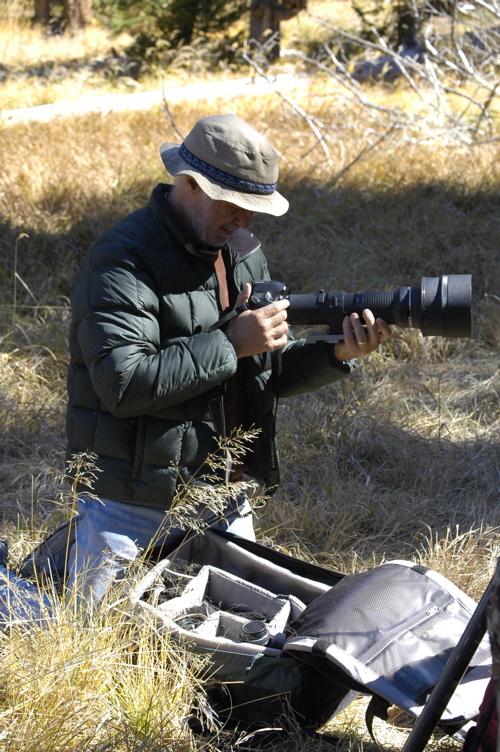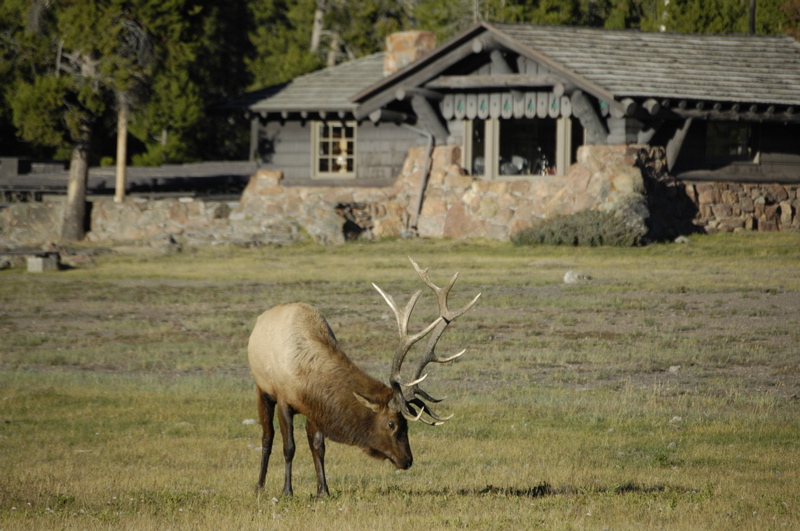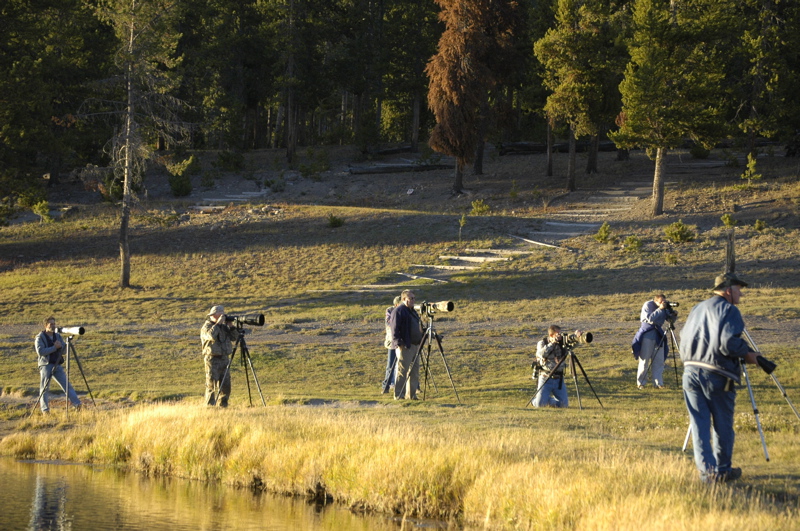31 degrees at 8:30 a.m. / -97 amp-hours cumulative (24 amp-hours used overnight)
Yesterday a couple known to Bert and Janie through the Outdoor Writer’s Association showed up. Eric and Sue are a photographer/writer team who have been published just about everywhere. Last night Eric showed us some incredible photos he’d captured of a Great Gray Owl here in Yellowstone, and we resolved to go out to the same spot and find that owl again.
So began the Great Gray Owl Hunt. We hit the road in the late morning and pulled off about 20 miles from our campsite in the area where the owl was known to be living. This was the moment I’d been waiting for — not to see the owl, but to simply have a chance to go tramping around in the forests of Yellowstone on a beautiful clear day in September.
Up to this point all of our explorations had been roadside. In Yellowstone, that’s where most people should remain. There are dozens of interesting pullouts and sites to see, and you don’t really have to hike the backcountry to get a good feel for the park. In fact, it’s better if the average yahoo doesn’t leave the roadway because they aren’t equipped to stay safe in a region where bears, bison, and boiling water are concealed around every turn.
There’s a book you can find in the visitor centers called “Death in Yellowstone.” It documents all the interesting ways people have managed to kill themselves here. Some of them are just painfully stupid (a tourist trying to mount a wild bison, or feeding a grizzly bear) and others are more the result of inadequate foreknowledge (freezing to death after getting lost, stumbling over an elk carcass that a bear had already laid claim to, falling through the fragile sinter surface near a thermal area, etc.). Anyway, if you don’t know what you are doing, it’s best to stick to the roadside attractions. A can of bear spray and a “never say die” attitude does not constitute sufficient preparation for a backcountry hike.
 Our little hike was more of a meander. Bert, Janie, Eric, and I all split up and explored separate quadrants of the search area, checking dead trees high and low for the large gray owl. The sky was blue, the air was comfortable (about 45 degrees with no wind), and the forest was filled with interesting things. We found a clump of bison fur, a mud wallow, all kinds of scat, elk bones, volcanic rocks, some gray jays, a woodpecker, and even — gulp — an elk carcass (fortunately too far gone to be of interest to anyone except insects). But no gray owl.
Our little hike was more of a meander. Bert, Janie, Eric, and I all split up and explored separate quadrants of the search area, checking dead trees high and low for the large gray owl. The sky was blue, the air was comfortable (about 45 degrees with no wind), and the forest was filled with interesting things. We found a clump of bison fur, a mud wallow, all kinds of scat, elk bones, volcanic rocks, some gray jays, a woodpecker, and even — gulp — an elk carcass (fortunately too far gone to be of interest to anyone except insects). But no gray owl.
I didn’t really care at all. It was so pleasant and beautiful everywhere we went that I was happy just to roam around in the meadows and trees, crunching through the dry grass and finding little natural items to show Emma later. I think we all felt that way, because after two or three hours of hunting the owl we were all in great spirits and not really disappointed. I would have been happy to pitch a tent and stay there for a few days, just listening to the trees and the bird calls.
In the evening Eleanor told us of a large male elk posing in the meadow adjacent to our campground. Bert and I headed over and caught some nice shots of this fellow and his three cows at sunset. He has seven prongs on one side, and eight on the other. Six prongs on a side is a “royal”, seven prongs is an “imperial” and eight prongs is a “monarch”, according to the ranger at Rocky Mountain National Monument.
We weren’t the only ones taking pictures this evening. Everywhere you go in Yellowstone, photographers are out with huge lenses and tripods, snapping away at the wildlife. Everyone wants to get that perfect shot, and when they’ve got it, they go back for more because you can always hope to find a better one.
I can understand this. Normally when I’m shooting I have to work fast and hard, capturing images under time pressure before we move on or the subject does. Here in Yellowstone, I was able to slow down and take photos for the sheer pleasure of it. Bert and I stood out in the grassy field for over an hour just shooting this one bull elk as he ate, herded his cows, bugled, and finally sat down at sunset. A dozen other photographers were there the entire time as well. It was a fun exercise taken for no other reason than simply wanting to stay and observe this magnificent elk.
Our solar gain report for the day:
Clear. At 7 p.m. cumulative amp-hours were -67. 30 amp-hours gained.



